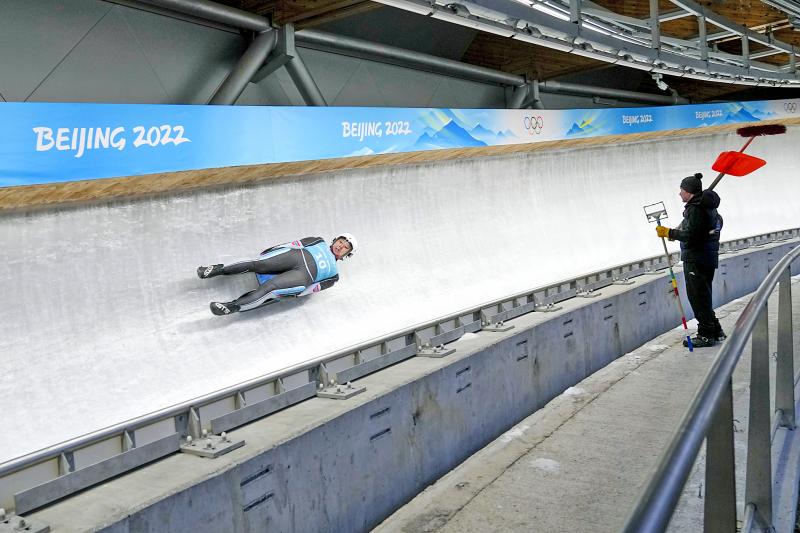An incident involving a Dutch reporter in the middle of a live broadcast who was dragged away by Chinese security officials was an isolated event and would not affect foreign media’s reporting at the Beijing Games, the International Olympic Committee (IOC) said yesterday.
The journalist, Sjoerd den Daas, was delivering his live report to public broadcaster NOS on Friday evening during the Games’ opening ceremony in the Chinese capital when several security officials surrounded him and one of them forcefully dragged him away.
Another security officer attempted to hold his hand in front of the camera as the reporter tried to continue speaking.

Photo: AP
The broadcaster had to interrupt the link with the reporter, leaving the studio anchor in the Netherlands confused.
“Obviously we have been in touch with the NOS, the state broadcaster, and it was an unfortunate circumstance,” IOC spokesman Mark Adams said. “I think someone was being overzealous. He [the reporter] was able to, very quickly afterward with the help of officials there, do his piece to camera.”
Games participants, including media, are restricted to a “closed loop,” which includes the venues, the media center and accommodations.
All participants must remain in that loop for the entire duration of the Games as part of China’s measures to minimize the risk of any COVID-19 spread during the Games until Feb. 20.
There have been concerns over whether visiting media would be allowed to freely do their job in China during the Olympics.
However, the IOC has repeatedly assured them that the contract signed with the Chinese hosts would allow every participant, including athletes and media, to speak freely within the loop.
“These things do happen, and I think it’s a one-off. I hope it’s a one-off, and we will assure you that within the closed loop you will be able to carry on your work,” Adams said.

The Central Weather Administration (CWA) yesterday said it expected to issue a sea warning for Typhoon Fung-Wong tomorrow, which it said would possibly make landfall near central Taiwan. As of 2am yesterday, Fung-Wong was about 1,760km southeast of Oluanpi (鵝鑾鼻), Taiwan’s southernmost point, moving west-northwest at 26kph. It is forecast to reach Luzon in the northern Philippines by tomorrow, the CWA said. After entering the South China Sea, Typhoon Fung-Wong is likely to turn northward toward Taiwan, CWA forecaster Chang Chun-yao (張峻堯) said, adding that it would likely make landfall near central Taiwan. The CWA expects to issue a land

Taiwan’s exports soared to an all-time high of US$61.8 billion last month, surging 49.7 percent from a year earlier, as the global frenzy for artificial intelligence (AI) applications and new consumer electronics powered shipments of high-tech goods, the Ministry of Finance said yesterday. It was the first time exports had exceeded the US$60 billion mark, fueled by the global boom in AI development that has significantly boosted Taiwanese companies across the international supply chain, Department of Statistics Director-General Beatrice Tsai (蔡美娜) told a media briefing. “There is a consensus among major AI players that the upcycle is still in its early stage,”

The Central Weather Administration (CWA) yesterday said it is expected to issue a sea warning for Typhoon Fung-wong this afternoon and a land warning tomorrow. As of 1pm, the storm was about 1,070km southeast of Oluanpi (鵝鑾鼻), Taiwan’s southernmost point, and was moving west-northwest at 28 to 32kph, according to CWA data. The storm had a radius of 250km, with maximum sustained winds of 173kph and gusts reaching 209kph, the CWA added. The storm is forecast to pass near Luzon in the Philippines before entering the South China Sea and potentially turning northward toward Taiwan, the CWA said. CWA forecaster Chang Chun-yao (張峻堯) said

Japanese Prime Minister Sanae Takaichi yesterday said that China using armed force against Taiwan could constitute a "survival-threatening situation" for Japan, allowing the country to mobilize the Japanese armed forces under its security laws. Takaichi made the remarks during a parliamentary session while responding to a question about whether a "Taiwan contingency" involving a Chinese naval blockade would qualify as a "survival-threatening situation" for Japan, according to a report by Japan’s Asahi Shimbun. "If warships are used and other armed actions are involved, I believe this could constitute a survival-threatening situation," Takaichi was quoted as saying in the report. Under Japan’s security legislation,